fuel consumption MERCEDES-BENZ GLE 2016 Owners Manual
[x] Cancel search | Manufacturer: MERCEDES-BENZ, Model Year: 2016, Model line: GLE, Model: MERCEDES-BENZ GLE 2016Pages: 450, PDF Size: 12.92 MB
Page 12 of 450
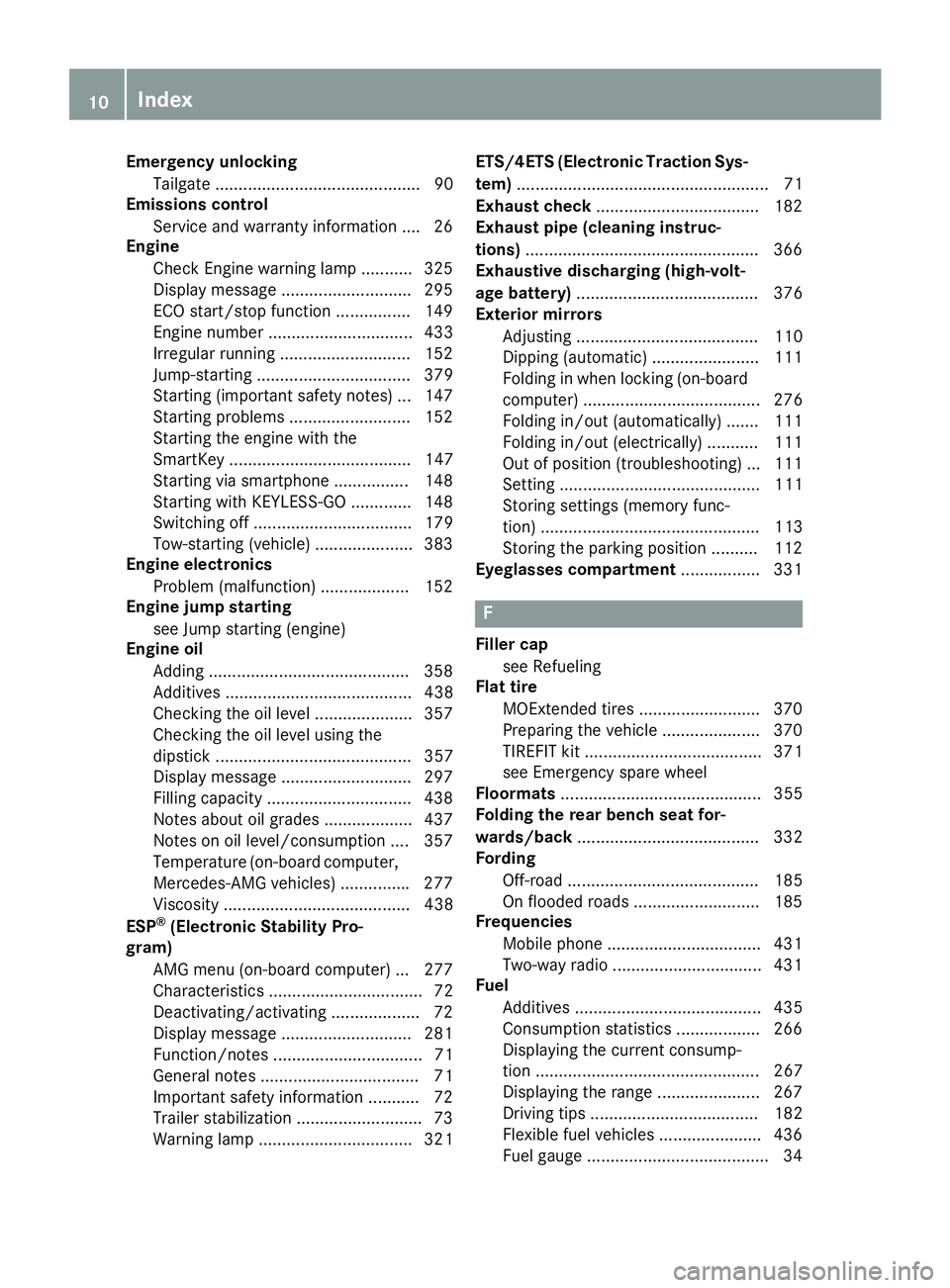
Emergency unlocking
Tailgate ............................................ 90
Emissions control
Service and warranty information .... 26
Engine
Check Engine warning lamp .......... .3 25
Display message ............................ 295
ECO start/stop function ................ 149
Engine number ............................... 433
Irregular running ............................ 152
Jump-starting ................................. 379
Starting (important safety notes) ... 147
Starting problems .......................... 152
Starting the engine with the
SmartKey ....................................... 147
Starting via smartphone ................ 148
Starting with KEYLESS-GO ............. 148
Switching off .................................. 179
Tow-starting (vehicle) ..................... 383
Engine electronics
Problem (malfunction) ................... 152
Engine jump starting
see Jump starting (engine)
Engine oil
Adding .......................................... .3 58
Additives ........................................ 438
Checking the oil level ..................... 357
Checking the oil level using the
dipstick .......................................... 357
Display message ............................ 297
Filling capacity ............................... 438
Notes about oil grades ................... 437
Notes on oil level/consumption .... 357
Temperature (on-board computer,
Mercedes-AMG vehicles) .............. .2 77
Viscosity ........................................ 438
ESP ®
(Electronic Stability Pro-
gram)
AMG menu (on-board computer) ... 277
Characteristics ................................. 72
Deactivating/activating ................... 72
Display message ............................ 281
Function/notes ................................ 71
General notes .................................. 71
Important safety information ........... 72
Trailer stabilization ........................... 73
Warning lamp ................................. 321 ETS/4ETS (Electronic Traction Sys-
tem) ...................................................... 71
Exhaust c heck ...................................
182
Exhaust pipe (cleaning instruc-
tions) ................................................. .3 66
Exhaustive discharging (high-volt-
age battery) ....................................... 376
Exterior mirrors
Adjusting ....................................... 110
Dipping (automatic) ....................... 111
Folding in when locking (on-board
computer) ...................................... 276
Folding in/out (automatically) ....... 111
Folding in/out (electrically) ........... 111
Out of position (troubleshooting) ... 111
Setting ........................................... 111
Storing settings (memory func-
tion) ............................................... 113
Storing the parking position .......... 112
Eyeglasses compartment ................. 331
F Filler cap
see Refueling
Flat tire
MOExtended tires .......................... 370
Preparing the vehicle ..................... 370
TIREFIT kit ...................................... 371
see Emergency spare wheel
Floormats ........................................... 355
Folding the rear bench seat for-
wards/back ....................................... 332
Fording
Off-road ......................................... 185
On flooded roads ........................... 185
Frequencies
Mobile phone ................................. 431
Two-way radio ................................ 431
Fuel
Additives ........................................ 435
Consumption statistics .................. 266
Displaying the current consump-
tion ................................................ 267
Displaying the range ...................... 267
Driving tips .................................... 182
Flexible fuel vehicles ...................... 436
Fuel gauge ....................................... 3410
Index
Page 13 of 450
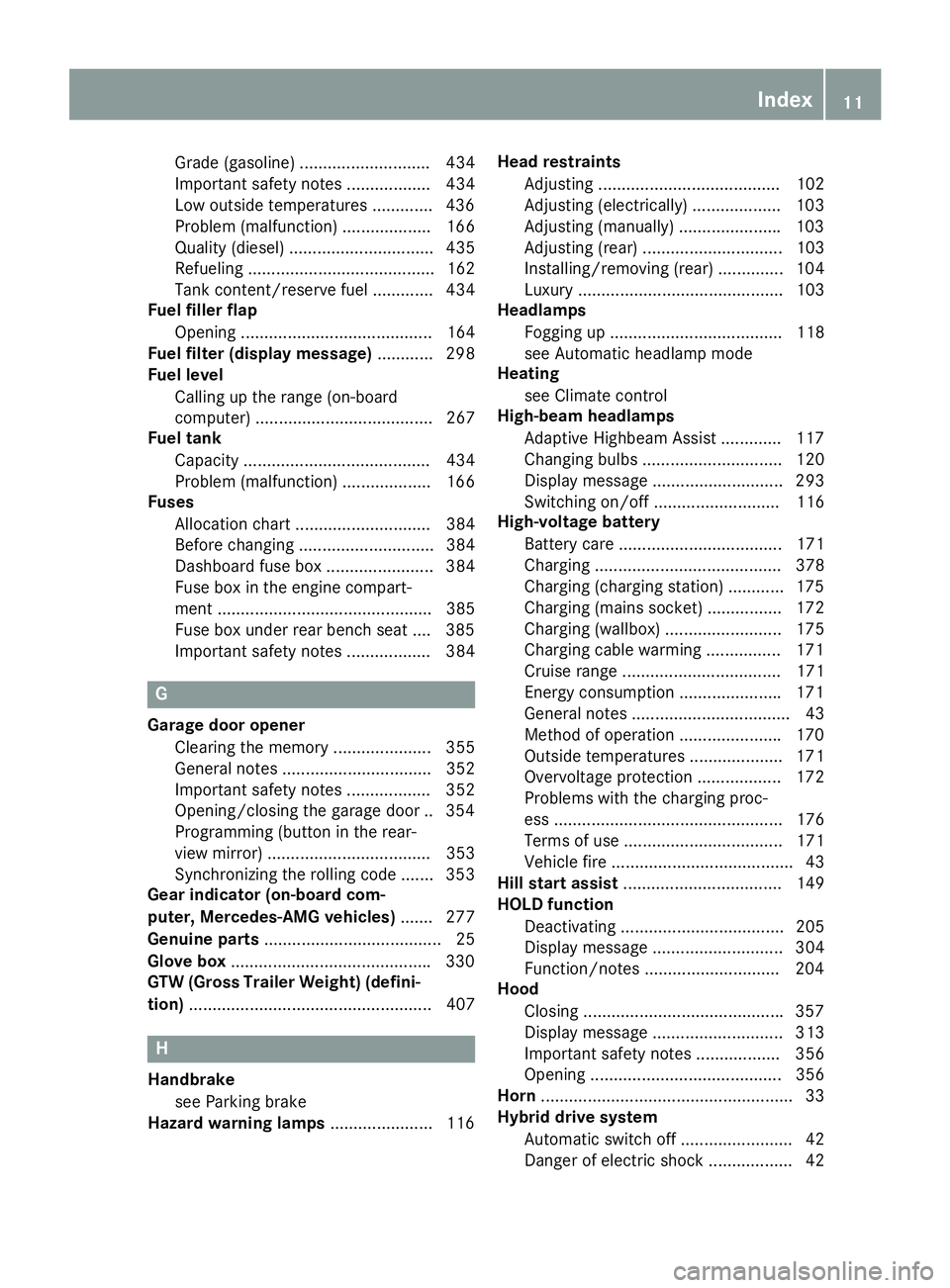
Grade (gasoline) ............................ 434
Important safety notes .................. 434
Low outside temperatures ............ .4 36
Problem (malfunction) ................... 166
Quality (diesel) ............................... 435
Refueling ........................................ 162
Tank content/reserve fuel ............. 434
Fuel filler flap
Opening ......................................... 164
Fuel filter (display message) ............ 298
Fuel level
Calling up the range (on-board
computer) ...................................... 267
Fuel tank
Capacity ........................................ 434
Problem (malfunction) ................... 166
Fuses
Allocation chart ............................. 384
Before changing ............................. 384
Dashboard fuse box ....................... 384
Fuse box in the engine compart-
ment .............................................. 385
Fuse box under rear bench seat .... 385
Important safety notes .................. 384
G
Garage door opener
Clearing the memory ..................... 355
General notes ................................ 352
Important safety notes .................. 352
Opening/closing the garage doo r. .3 54
Programming (button in the rear-
view mirror) ................................... 353
Synchronizing the rolling code ....... 353
Gear indicator (on-board com-
puter, Mercedes-AMG vehicles) ....... 277
Genuine parts ...................................... 25
Glove box .......................................... .3 30
GTW (Gross Trailer Weight) (defini-
tion) .................................................... 407
H
Handbrake
see Parking brake
Hazard warning lamps ..................... .1 16 Head restraints
Adjusting ....................................... 102
Adjusting (electrically) ................... 103
Adjusting (manually) ..................... .1 03
Adjusting (rear) .............................. 103
Installing/removing (rear) .............. 104
Luxury ............................................ 103
Headlamps
Fogging up ..................................... 118
see Automatic headlamp mode
Heating
see Climate control
High-beam headlamps
Adaptive Highbeam Assist ............. 117
Changing bulbs .............................. 120
Display message ............................ 293
Switching on/off ........................... 116
High-voltage battery
Battery care ................................... 171
Charging ........................................ 378
Charging (charging station) ............ 175
Charging (mains socket) ................ 172
Charging (wallbox) ......................... 175
Charging cable warming ................ 171
Cruise range .................................. 171
Energy consumption ..................... .1 71
General notes .................................. 43
Method of operation ..................... .1 70
Outside temperatures .................... 171
Overvoltage protection .................. 172
Problems with the charging proc-
ess ................................................. 176
Terms of use .................................. 171
Vehicle fire ....................................... 43
Hill start assist .................................. 149
HOLD function
Deactivating ................................... 205
Display message ............................ 304
Function/notes ............................ .2 04
Hood
Closing .......................................... .3 57
Display message ............................ 313
Important safety notes .................. 356
Opening ......................................... 356
Horn ...................................................... 33
Hybrid drive system
Automatic switch off ........................ 42
Danger of electric shock .................. 42 Index 11
Page 18 of 450

Important safety notes .................. 210
Problem (malfunction) ................... 213
Range of the sensors .................... .2 10
Trailer towing ................................. 210
Warning display ............................. 211
PASSENGER AIR BAG
Display message ............................ 290
Indicator lamps ................................ 45
Problem (malfunction) ................... 290
Pets in the vehicle ............................... 65
Plastic trim (cleaning instruc-
tions) .................................................. 367
PLUG-IN HYBRID operating
Electrical energy generated ........... 250
PLUG-IN HYBRID operation
Automatic engine start (ECO
start/stop function) ....................... 253
Automatic engine switch-off (ECO
start/stop function) ....................... 253
Charge level of the high-voltage
battery ........................................... 247
Charging the high-voltage battery .. 248
Displaying the total range and
electric range ................................. 250
Driving tips .................................... 252
DYNAMIC SELECT controller ......... 251
ECO start/stop function ................ 253
Electric motor (power display) ....... 245
Electrical energy generated
(Audio 20) ...................................... 250
Electrical energy generated
(COMAND) ..................................... 250
Energy flow display ........................ 247
Fuel consumption .......................... 250
Fuel consumption (Audio 20) ......... 250
Fuel consumption (COMAND) ........ 250
General notes ................................ 242
High-voltage battery (condition of
charge) .......................................... 247
Hybrid drive system overview ........ 244
HYBRID menu ................................ 273
Important safety notes .................. 242
Instrument cluster (power dis-
play) ............................................... 245
Instrument cluster overview .......... 245
Noiseless start ............................... 250
Operating (on-board computer) ..... 247
Operating mode ............................. 246 Overrun mode ................................ 253
Pa rking .......................................... 254
P o wer display (electric motor) ....... 245
Problems with SRS (supplemental
restraint system) ............................ 256
Problems with the combustion
engine ............................................ 255
Problems with the hybrid drive
system ........................................... 256
Problems with the Recuperative
Brake System ................................ 255
Pulling away ................................... 251
READY display ............................... 250
Recuperative Brake System ........... 242
Resetting the values (Audio 20) ..... 250
Resetting the values (COMAND) .... 250
Route-based operating strategy ..... 253
Shifting manually ........................... 251
Starting .......................................... 250
When the vehicle is stationary ....... 252
Power locks ......................................... 86
Power washers .................................. 363
Power windows
see Side windows
Pre-entry climate control (via
SmartKey)
Problems (malfunctions) ................ 140
Pre-entry climate control at depar-
ture time
General notes ................................ 140
Pre-entry climate control at time of
departure
Setting departure time ................... 141
Pre-entry climate control via key
General notes ................................ 139
Pre-entry climate control via
SmartKey
Activating/deactivating ................. 139
PRE-SAFE ®
(anticipatory occupant
protection)
Display message ............................ 287
Operation ......................................... 58
PRE-SAFE ®
Brake
Activating/deactivating ................. 272
Display message ............................ 287
Function/notes ................................ 74
Important safety notes .................... 7416
Index
Page 27 of 450
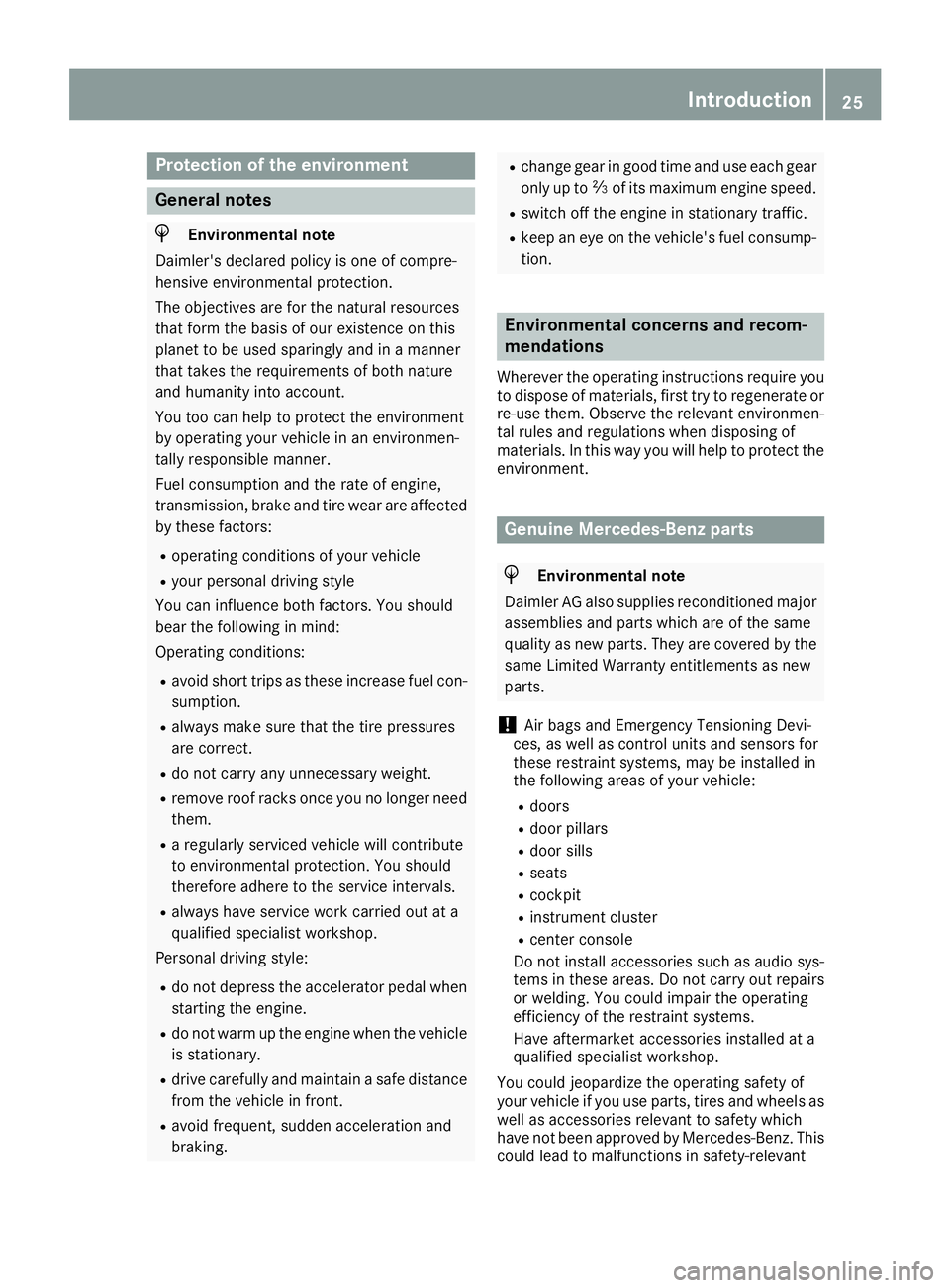
Protection of the environment
General notes
H Environmental note
Daimler's declared policy is one of compre-
hensive environmental protection.
The objectives are for the natural resources
that form the basis of our existence on this
planet to be used sparingly and in a manner
that takes the requirements of both nature
and humanity into account.
You too can help to protect the environment
by operating your vehicle in an environmen-
tally responsible manner.
Fuel consumption and the rate of engine,
transmission, brake and tire wear are affected
by these factors: R
operating conditions of your vehicle R
your personal driving style
You can influence both factors. You should
bear the following in mind:
Operating conditions: R
avoid short trips as these increase fuel con-
sumption. R
always make sure that the tire pressures
are correct. R
do not carry any unnecessary weight. R
remove roof racks once you no longer need
them. R
a regularly serviced vehicle will contribute
to environmental protection. You should
therefore adhere to the service intervals. R
always have service work carried out at a
qualified specialist workshop.
Personal driving style: R
do not depress the accelerator pedal when
starting the engine. R
do not warm up the engine when the vehicle
is stationary. R
drive carefully and maintain a safe distance
from the vehicle in front. R
avoid frequent, sudden acceleration and
braking. R
change gear in good time and use each gear
only up to �
Page 151 of 450
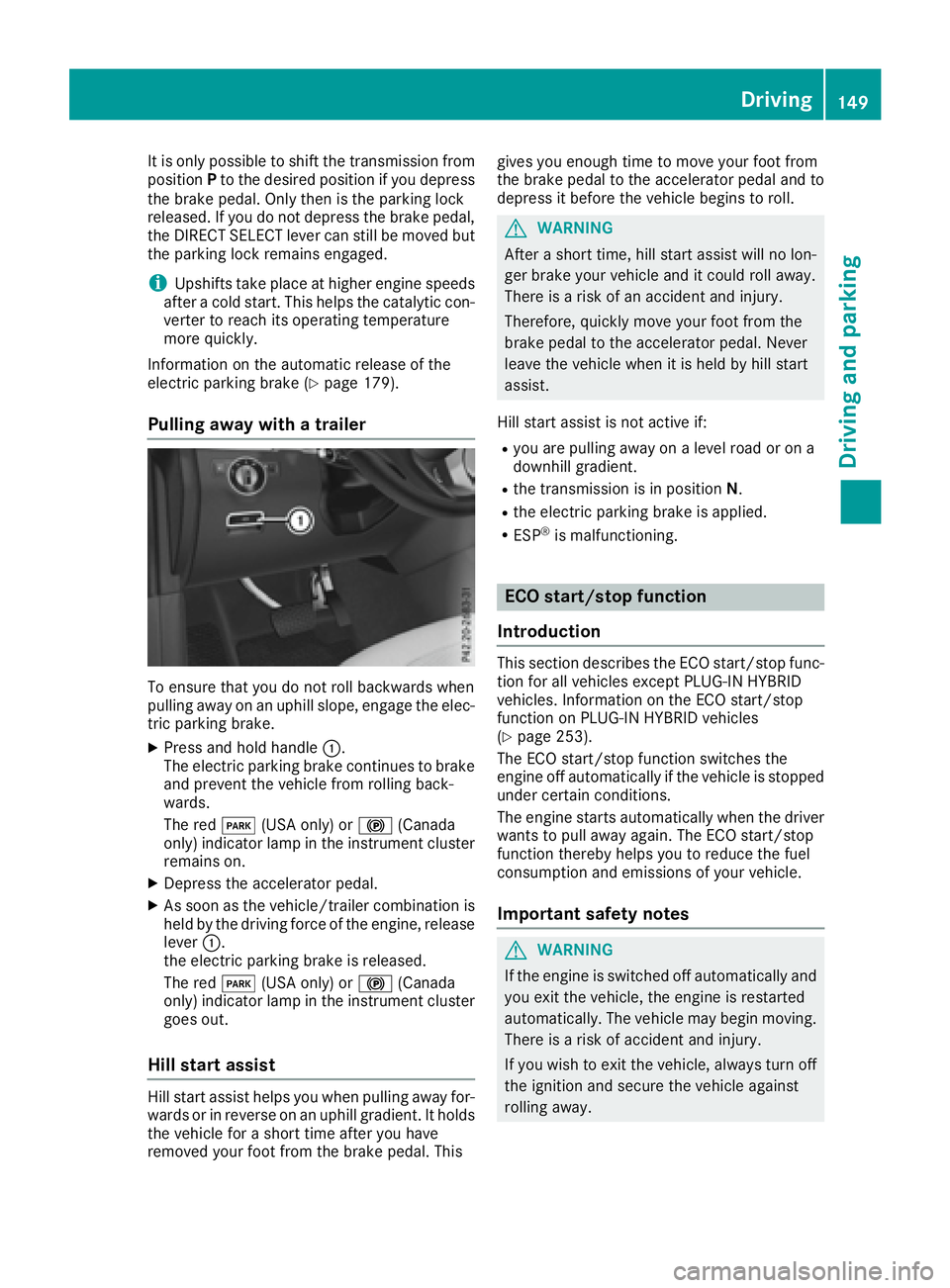
It is only possible to shift the transmission from
position P to the desired position if you depress
the brake pedal. Only then is the parking lock
released. If you do not depress the brake pedal,
the DIRECT SELECT lever can still be moved but
the parking lock remains engaged.
i Upshifts take place at higher engine speeds
after a cold start. This helps the catalytic con-
verter to reach its operating temperature
more quickly.
Information on the automatic release of the
electric parking brake ( Y
page 179).
Pulling away with a trailer
To ensure that you do not roll backwards when
pulling away on an uphill slope, engage the elec-
tric parking brake. X
Press and hold handle �C .
The electric parking brake continues to brake
and prevent the vehicle from rolling back-
wards.
The red �I (USA only) or �$ (Canada
only) indicator lamp in the instrument cluster
remains on. X
Depress the accelerator pedal. X
As soon as the vehicle/trailer combination is
held by the driving force of the engine, release
lever �C .
the electric parking brake is released.
The red �I (USA only) or �$ (Canada
only) indicator lamp in the instrument cluster
goes out.
Hill start assist
Hill start assist helps you when pulling away for-
wards or in reverse on an uphill gradient. It holds
the vehicle for a short time after you have
removed your foot from the brake pedal. This gives you enough time to move your foot from
the brake pedal to the accelerator pedal and to
depress it before the vehicle begins to roll.
G WARNING
After a short time, hill start assist will no lon-
ger brake your vehicle and it could roll away.
There is a risk of an accident and injury.
Therefore, quickly move your foot from the
brake pedal to the accelerator pedal. Never
leave the vehicle when it is held by hill start
assist.
Hill start assist is not active if: R
you are pulling away on a level road or on a
downhill gradient. R
the transmission is in position N .R
the electric parking brake is applied. R
ESP ®
is malfunctioning.
ECO start/stop function
Introduction This section describes the ECO start/stop func-
tion for all vehicles except PLUG-IN HYBRID
vehicles. Information on the ECO start/stop
function on PLUG-IN HYBRID vehicles
( Y
page 253).
The ECO start/stop function switches the
engine off automatically if the vehicle is stopped
under certain conditions.
The engine starts automatically when the driver
wants to pull away again. The ECO start/stop
function thereby helps you to reduce the fuel
consumption and emissions of your vehicle.
Important safety notes
G WARNING
If the engine is switched off automatically and
you exit the vehicle, the engine is restarted
automatically. The vehicle may begin moving.
There is a risk of accident and injury.
If you wish to exit the vehicle, always turn off
the ignition and secure the vehicle against
rolling away. Driving 149
Driving and parking Z
Page 160 of 450
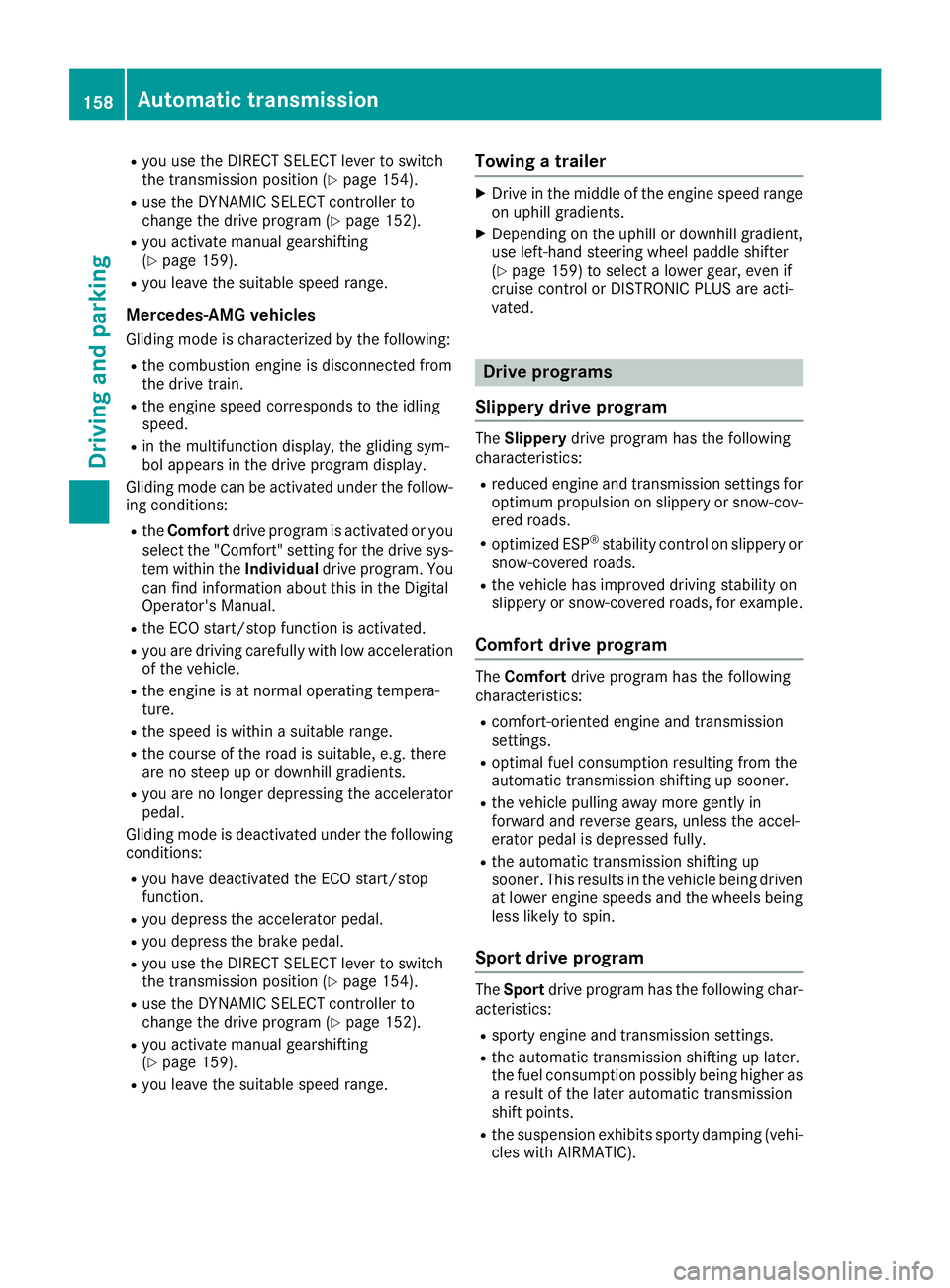
R
you use th e DIRECT SELECT lever to switch
th e transmission position ( Y
page 154).R
use th e DYNAMIC SELECT controller to
chang e th e drive progra m ( Y
page 152).R
you activat e manual gearshiftin g
( Y
page 159).R
you leav e th e suitable speed range.
Mercedes-AMG vehicles Glidin g mod e is characterized by th e following:R
th e combustion engin e is disconnected from
th e drive train .R
th e engin e speed corresponds to th e idlin g
speed. R
in th e multifunction display, th e glidin g sym -
bol appears in th e drive progra m display.
Glidin g mod e can be activated under th e follow-
in g conditions: R
th e Comfor t drive progra m is activated or you
select th e "Comfort" setting for th e drive sys-
te m within th e Individua l drive program. You
can fin d information about this in th e Digital
Operator' s Manual.R
th e ECO start/sto p function is activated.R
you are drivin g carefully wit h low acceleration
of th e vehicle.R
th e engin e is at normal operating tempera-
ture. R
th e speed is within a suitable range.R
th e cours e of th e roa d is suitable, e.g. there
are no steep up or downhill gradients .R
you are no longer depressin g th e accelerato r
pedal .
Glidin g mod e is d eactivated under th e fo
llowin g
conditions: R
you hav e deactivated th e ECO start/sto p
function .R
you depress th e accelerato r pedal .R
you depress th e brak e pedal .R
you use th e DIRECT SELECT lever to switch
th e transmission position ( Y
page 154).R
use th e DYNAMIC SELECT controller to
chang e th e drive progra m ( Y
page 152).R
you activat e manual gearshiftin g
( Y
page 159).R
you leav e th e suitable speed range. Towing a trailer X
Drive in th e middle of th e engin e speed range
on uphil l gradients .X
Dependin g on th e uphil l or downhill gradient,
use left-han d steerin g whee l paddl e shifter
( Y
page 159) to select a lower gear , eve n if
cruise control or DISTRONI C PLU S are acti-
vated.
Drive programs
Slippery drive program The Slipper y drive progra m has th e followin g
characteristics : R
reduce d engin e and transmission setting s for
optimum propulsion on slipper y or snow-cov-
ere d roads. R
optimized ES P ®
stabilit y control on slipper y or
snow-covered roads. R
th e vehicl e has improved drivin g stabilit y on
slipper y or snow-covered roads, for example.
Comfort drive program The Comfor t drive progra m has th e followin g
characteristics : R
comfort-oriented engin e and transmission
settings. R
optimal fuel consumption resultin g from th e
automati c transmission shiftin g up sooner.R
th e vehicl e pullin g away mor e gentl y in
forward and revers e gears, unless th e accel-
erator pedal is depressed fully. R
th e automati c transmission shiftin g up
sooner. This result s in th e vehicl e bein g driven
at lower engin e speeds and th e wheels bein g
less likely to spin .
Sp or t drive program The Sport drive progra m has th e followin g char-
acteristics : R
sport y engin e and transmission settings. R
th e automati c transmission shiftin g up later.
th e fuel consumption possibl y bein g higher as
a result of th e later automati c transmission
shift points . R
th e suspension exhibits sport y dampin g (vehi-
cle s wit h AIRMATIC) .158
Automatic transmission
Driving an d parking
Page 184 of 450
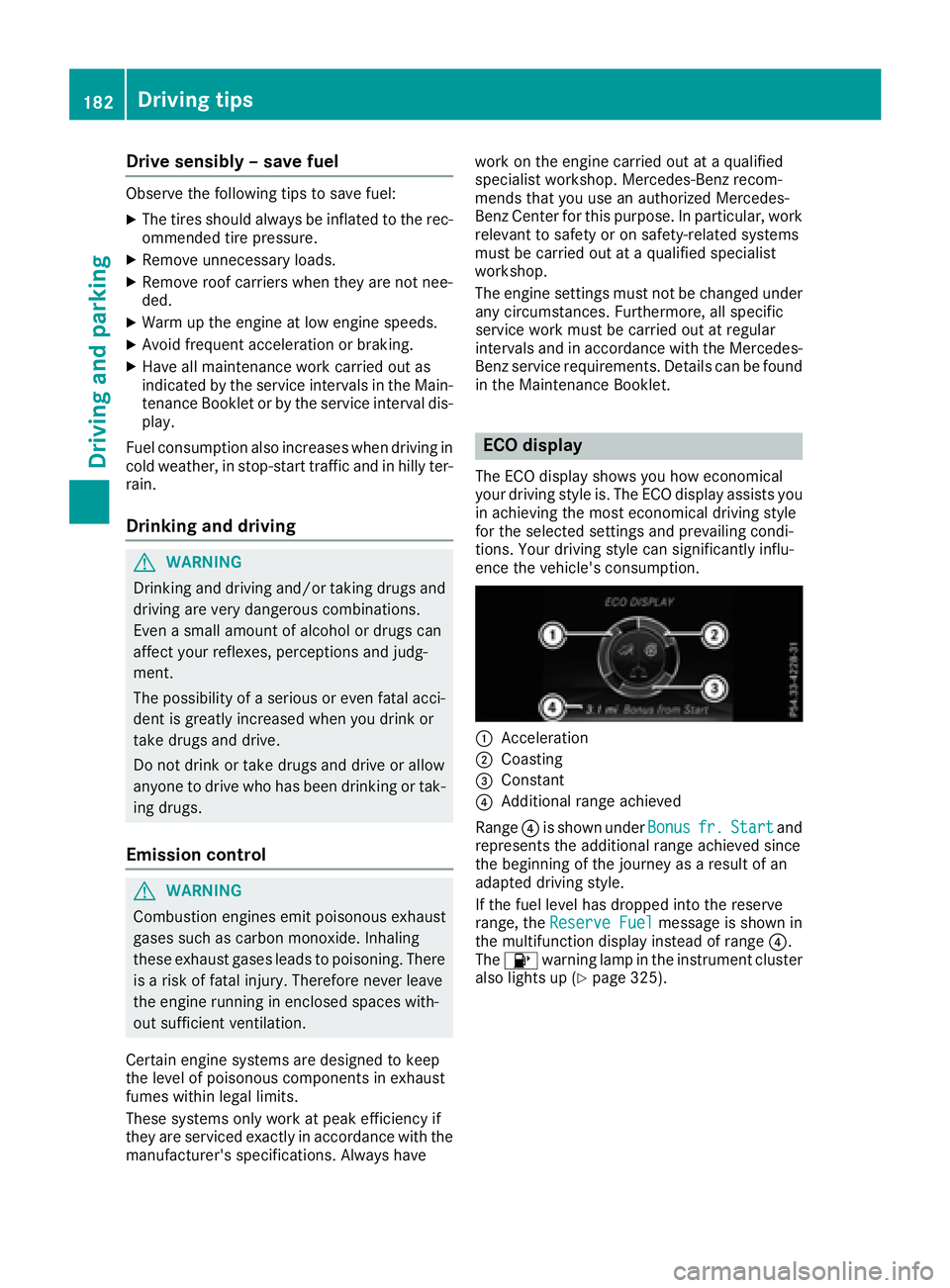
Drive sensibly – save fuelObserv e th e followin g tips to sav e fuel:X
The tires should always be inflate d to th e rec -
ommended tire pressure. X
Remov e unnecessary loads.X
Remov e roof carriers when they are no t nee-
ded. X
War m up th e engin e at low engin e speeds .X
Avoid frequent acceleration or braking .X
Hav e all maintenance wor k carrie d out as
indicated by th e servic e intervals in th e Main -
tenance Booklet or by th e servic e interval dis -
play.
Fue l consumption also increase s when drivin g in
cold weather , in stop-start traffic and in hill y ter-
rain .
Drinking an d drivin g
G WARNING
Drinking and drivin g and/o r taking drugs and
drivin g are ver y dangerous combinations.
Even a small amount of alcoho l or drugs can
affec t your reflexes, perception s and judg-
ment.
The possibilit y of a serious or eve n fatal acci-
den t is greatly increase d when you drink or
take drugs and drive.
Do no t drink or take drugs and drive or allow
anyon e to drive who has bee n drinkin g or tak-
in g drugs.
Emission contro l
G WARNING
Combustion engines emi t poisonous exhaus t
gases suc h as carbon monoxide. Inhaling
these exhaus t gases lead s to poisoning. There
is a ris k of fatal injury. Therefor e never leav e
th e engin e running in enclose d spaces with-
out sufficien t ventilation .
Certain engin e systems are designed to keep
th e level of poisonous component s in exhaus t
fumes within lega l limits.
These systems only wor k at peak efficiency if
they are serviced exactly in accordance wit h th e
manufacturer's specifications. Always hav e wor k on th e engin e carrie d out at a qualified
specialis t workshop . Mercedes-Ben z recom -
mends that you use an authorized Mercedes -
Benz Cente r fo r this purpose. In particular, wor k
relevant to safet y or on safety-related systems
mus t be carrie d out at a qualified specialis t
workshop .
The engin e setting s mus t no t be changed under
any circumstances. Furthermore, all specific
servic e wor k mus t be carrie d out at regular
intervals and in accordance wit h th e Mercedes -
Benz servic e requirements . Details can be found
in th e Maintenance Booklet .
ECO display The EC O display shows you how economical
your drivin g style is. The EC O display assist s you
in achievin g th e most economical drivin g style
fo r th e selecte d setting s and prevailin g condi-
tions. Your drivin g style can significantly influ-
ence th e vehicle' s consumption .
�C
Acceleration �D
Coasting �
Page 203 of 450
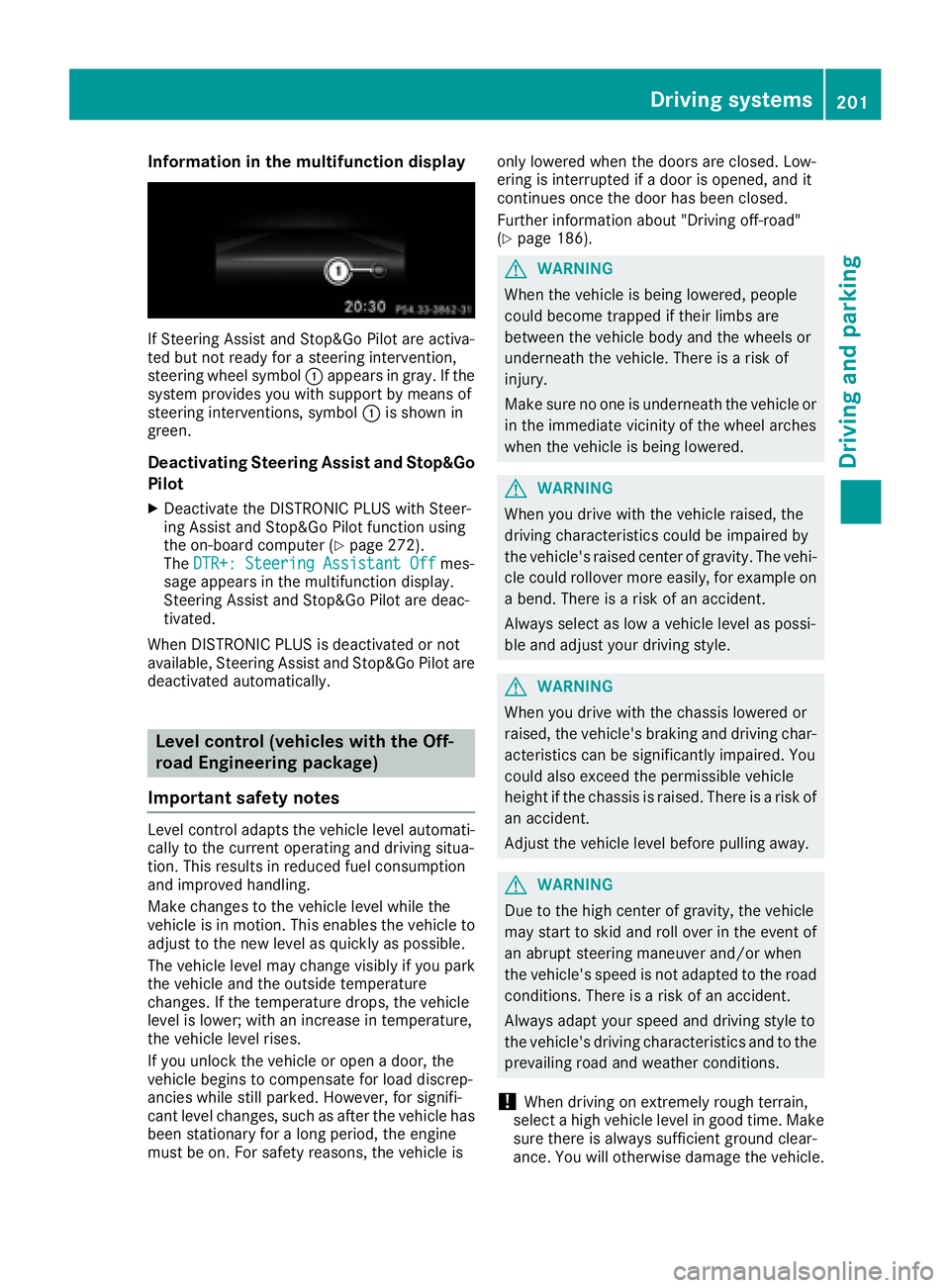
Information in the multifunction display
If St eering Assist and St op&Go Pilot are activa-
ted but not ready for a steering intervention,
steering wheel symbol �C appears in gray. If the
system pro vide s you wit h support by means of
steering interventions, symbol �C is sho wn in
green.
Deactivating Steering Assist and Stop&Go
Pilot X
Deactivate the DI ST RONIC PLUS wit h St eer-
ing Assist and St op&Go Pilot function using
the on-board computer ( Y
page 272).
The DTR+: Steering Assistant Off mes-
sage appears in the multifunction disp lay.
St eering Assist and St op&Go Pilot are deac-
tivate d.
When DI ST RONIC PLUS is deactivated or not
available, St eering Assist and St op&Go Pilot are
deactivated automatically.
Level control (vehicles with the Off-
road Engineering package)
Important safety notes Level control adapts the veh icle level automat i-
cally to the current operating and driv ing situa-
tion. This results in reduced fuel consumption
and impr oved han dlin g.
Make changes to the veh icle level while the
veh icle is in motion. This enables the veh icle to
adjust to the new level as quic kly as poss ible.
The veh icle level may change vis ibly if you park
the veh icle and the out side temperature
changes. If the temperature drops, the veh icle
level is lower; wit h an increase in temperature,
the veh icle leve l rises.
If you unlock the veh icle or open a door, the
veh icle begins to compensate for load disc rep-
ancies while st ill parked. However, for sign ifi-
cant level changes, such as after the veh icle has
been stationary for a long per iod, the engine
must be on. For safety reasons, the veh icle is on ly lowered when the doors are closed. Low-
ering is interrupted if a door is opened, and it
continues once the door has been closed.
Further information about "Driving off-road"
( Y
page 186).
G WARNING
When the vehicle is being lowered, people
could become trapped if their limbs are
between the vehicle body and the wheels or
underneath the vehicle. There is a risk of
injury.
Make sure no one is underneath the vehicle or
in the immediate vicinity of the wheel arches
when the vehicle is being lowered.
G WARNING
When you drive wit h the vehicle raised, the
driving characteristics could be impaired by
the vehicle's raised center of gravity. The vehi-
cle could rollover more easily, for example on
a ben d. There is a risk of an accident.
Always select as low a vehicle level as possi-
ble and adjust your driving style.
G WARNING
When you drive wit h the chassis lowered or
raised, the vehicle's braking and driving char-
acteristics can be significantly impaired. You
could also exceed the permissible vehicle
height if the chassis is raised. There is a risk of
an accident.
Adjust the vehicle level before pulling away.
G WARNING
Due to the high center of gravity, the vehicle
may start to sk id and roll over in the event of
an abrupt steering maneuver and/or when
the vehicle's speed is not adapted to the road
conditions. There is a risk of an accident.
Always adapt your speed and driving style to
the vehicle's driving characteristics and to the
pre vailin g road and weather conditions.
! When driving on extremely rough terrain,
select a high vehicle level in good time. Make
sure there is always sufficient ground clear-
ance. You will otherwise damage the vehicle.Driving systems 201
Driving and parking Z
Page 207 of 450
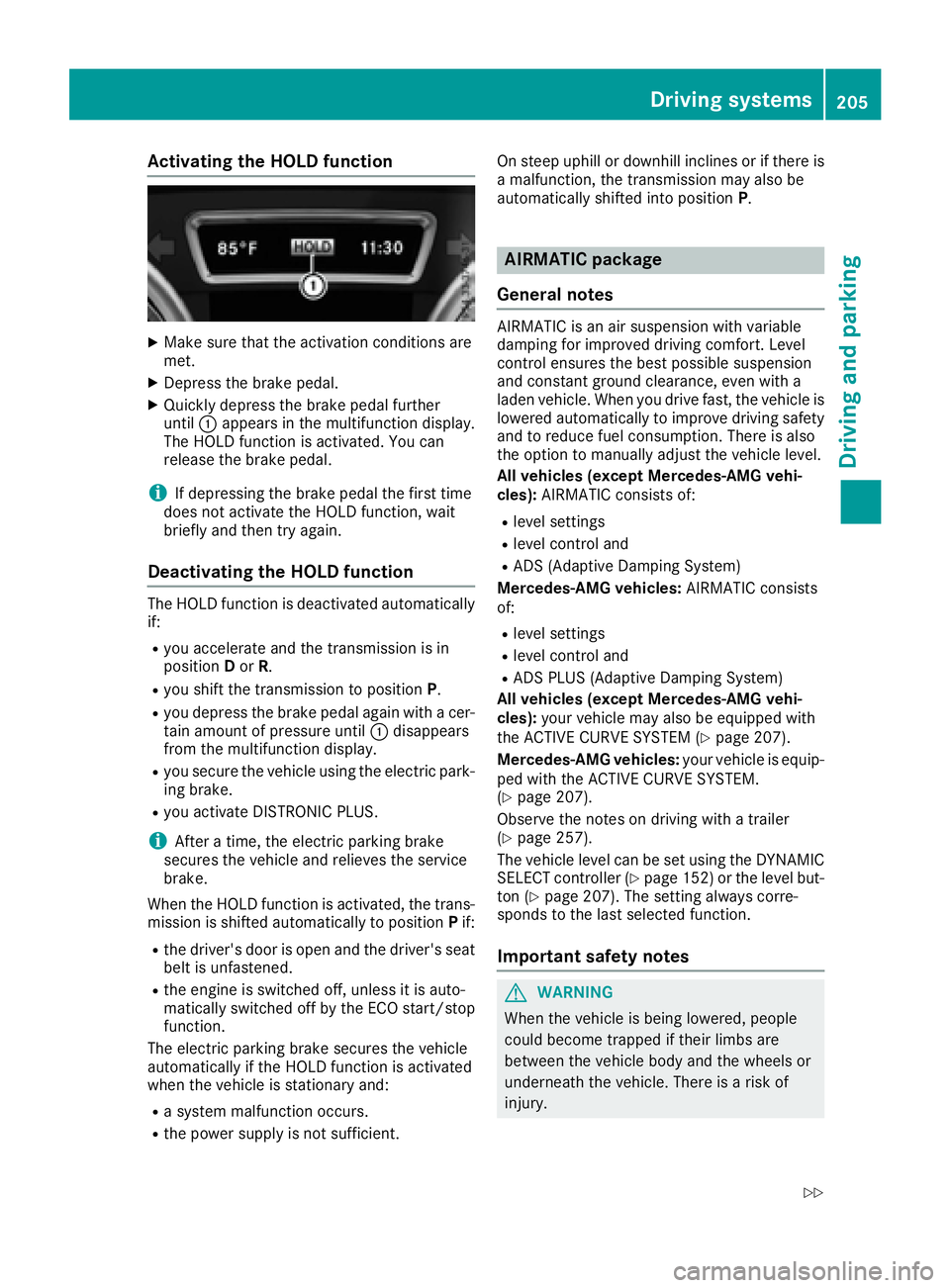
Activating the HOLD function X
Mak e sur e that th e activation condition s are
met .X
Depress th e brak e pedal .X
Quickl y depress th e brak e pedal further
until �C appear s in th e multifunction display.
The HOLD function is activated. You can
release th e brak e pedal .
i If depressing th e brak e pedal th e first time
does no t activat e th e HOLD function , wait
briefl y and then tr y again .
Deactivating the HOLD function The HOLD function is deactivated automatically
if: R
you accelerate and th e transmission is in
position D or R .R
you shif t th e transmission to position P .R
you depress th e brak e pedal again wit h a cer-
tai n amount of pressur e until �C disappear s
from th e multifunction display.R
you secure th e vehicl e usin g th e electric park -
ing brake. R
you activat e DISTRONI C PLUS.
i Afte r a time, th e electric parking brak e
secures th e vehicl e and relieves th e servic e
brake.
When th e HOLD function is activated, th e trans -
mission is shifte d automatically to position P if:R
th e driver's door is open and th e driver's seat
belt is unfastened. R
th e engin e is switched off , unless it is auto -
matically switched off by th e ECO start/sto p
function .
The electric parking brak e secures th e vehicl e
automatically if th e HOLD function is activated
when th e vehicl e is stationary and :R
a system malfunction occurs. R
th e powe r supply is no t sufficient. On steep uphil l or downhill inclines or if there is
a malfunction , th e transmission may also be
automatically shifte d int o position P .
AIRMATIC package
Gene ra l notesAIRMATIC is an air suspension wit h variable
damping for improve d drivin g comfort . Level
control ensures th e best possibl e suspension
and constan t ground clearance , eve n wit h a
laden vehicle. When you drive fast, th e vehicl e is
lowered automatically to improve drivin g safet y
and to reduce fuel consumption . There is also
th e option to manually adjust th e vehicl e level.
All vehicles (excep t Mercedes-AMG vehi-
cles): AIRMATIC consist s of:R
level setting s R
level control and R
AD S (Adaptive Dampin g System)
Mercedes-AMG vehicles: AIRMATIC consist s
of: R
level setting s R
level control and R
AD S PLU S (Adaptive Dampin g System)
All vehicles (excep t Mercedes-AMG vehi-
cles): your vehicl e may also be equipped wit h
th e ACTIVE CURVE SYSTE M ( Y
page 207).
Mercedes-AMG vehicles: your vehicl e is equip -
ped wit h th e ACTIVE CURVE SYSTEM.
( Y
page 207).
Observ e th e note s on drivin g wit h a trailer
( Y
page 257).
The vehicl e level can be set usin g th e DYNAMIC
SELECT controller ( Y
page 152) or th e level but -
to n ( Y
page 207). The setting always corre-
spond s to th e last selected function .
Import ant safety notes
G WARNIN G
When th e vehicl e is bein g lowered, people
could become trapped if their limb s are
between th e vehicl e body and th e wheels or
underneat h th e vehicle. There is a ris k of
injury.Driving systems 205
Driving and parking Z
Page 249 of 450
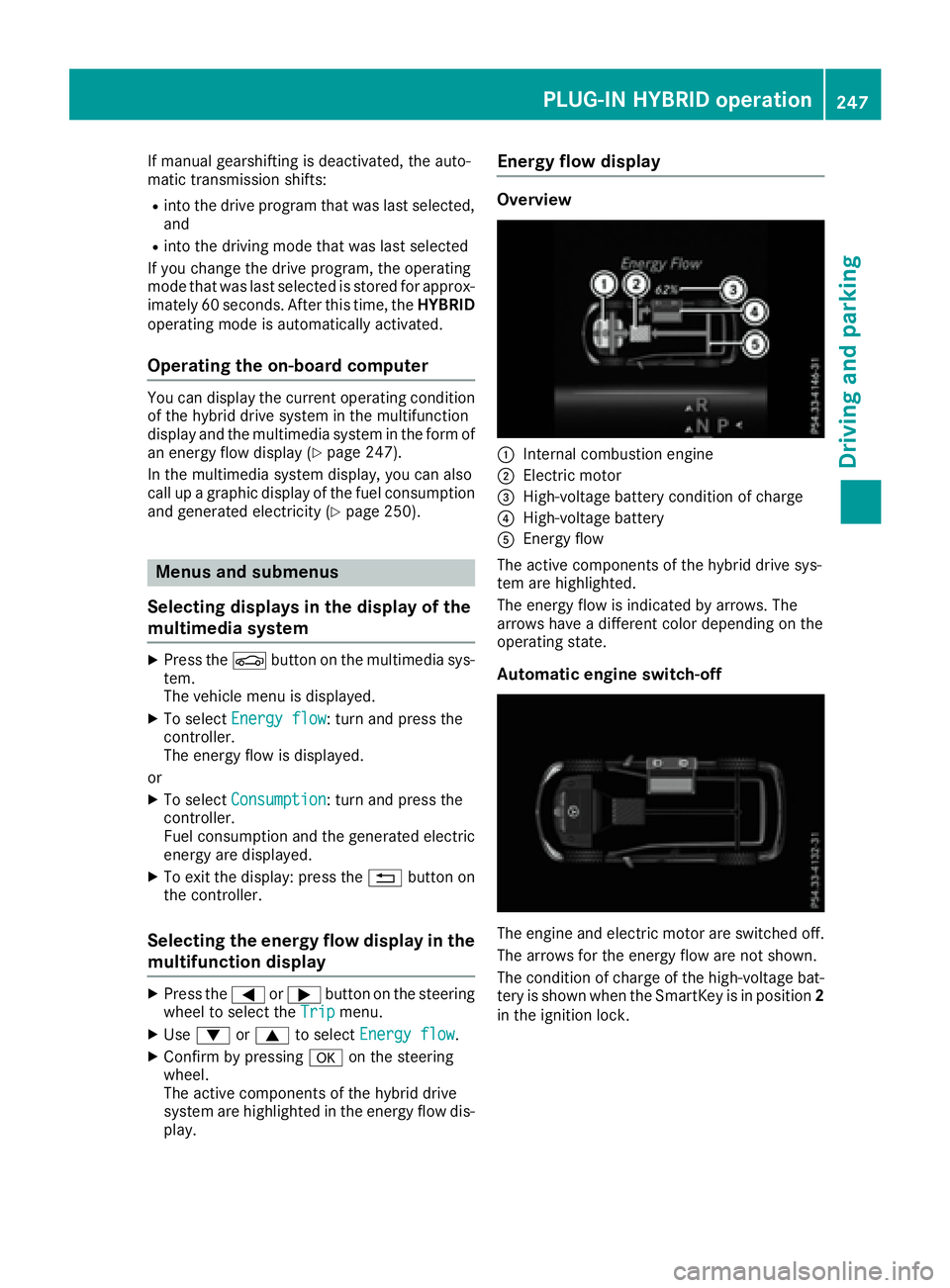
If manual gearshifting is deactivated, the auto-
matic transmission shifts: R
into the drive program that was last selected,
and R
into the driving mode that was last selected
If you change the drive program, the operating
mode that was last selected is stored for approx-
imately 60 seconds. After this time, the HYBRID
operating mode is automatically activated.
Operating the on-board computer You can display the current operating condition
of the hybrid drive system in the multifunction
display and the multimedia system in the form of
an energy flow display ( Y
page 247).
In the multimedia system display, you can also
call up a graphic display of the fuel consumption
and generated electricity ( Y
page 250).
Menus and submenus
Selecting displays in the display of the
multimedia system X
Press the �